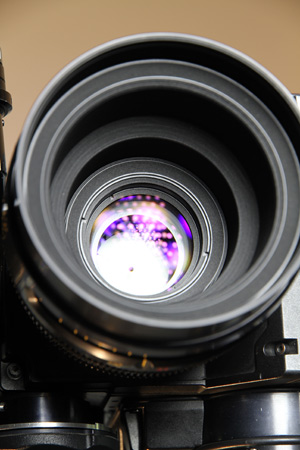by Albert Chen, Lemac Service Department (Optics), Melbourne.
The image potential of any camera depends ultimately on the piece of glass in front of it. As the saying goes “the lens is the heart of the camera.” Here is a simple Lemac guide on how to look after your investment.

Cleaning
- When there is dirt or dust on the lens surfaces, it should be removed with an air blower directed at a 45 degree angle about a foot and a half away then brushed gently with a fine hair brush. After this wipe the lens gently. Clean with a circular lifting motion so you are not just wiping but also lifting the dust off.
- Fingerprints and similar stains on the lens should be removed by applying a small amount of commercial lens cleaner (such as Rosco or Tiffen) to a clean, dry, cotton cloth or lens cleaning paper, and gently wipe in a circular motion from the centre toward the edge. Place front and rear covers on lens before proceeding to the next step. Care should be taken to remove any excess residue from lens cleaning fluid with a dry lens tissue.
- You can brush the metal surfaces with a bristle brush or a tooth brush removing dirt especially from the drive gears. Next wipe over with a soft dry cloth.
Lenses in humid and or wet locations
Lenses are not dust or waterproof. Provide adequate protection when using in adverse conditions such as dust, rain or snow. If water affected it should be wiped off, then sealed in a vinyl bag with a desiccating agent (silica gel) to absorb remaining moisture.

Note that sudden temperature changes should be avoided, such as from a cool room into warm and humid ambience. Instead store in airtight resealable bag till it reaches ambient temperature. This prevents fogging especially internally, rendering it unusable for a period of time. In some cases, the condensation leaves permanent stains on the coating. For this reason, lenses should be individually sealed in plastic bags prior to flights.
Handling precautions
Careless, rough handling is apt to occur during transition, but the utmost care should be taken to avoid strong impact. Also if the camera and lenses are used in dusty environment, it should be mounted and demounted quickly. Place a cover over the lens mount to prevent dirt and dust from getting in.
Zoom lenses should only be transported horizontally. They should always be focused near to infinity and zoomed near to the long end of their range and barrels taped to prevent movement during transit.
Hints for field checking of a zoom lens.
Check the front and rear elements and the mechanics of focus, zoom and iris to ensure functionality. With the lens mounted and well supported and viewfinder diopter correctly set. Open aperture fully, zoom to long end, focus the lens using a Siemen’s star chart. Locate a point on the cross hairs in the eyepiece and slowly zoom wide observing the following:
- point remans in focus through the zoom range.
- point remains in the same position through the zoom range.
- movement stays consistently smooth through the zoom range.
Hints for field checking of a prime lens.
Check the front and rear elements and the mechanics of focus and iris to ensure functionality.
With the lens mounted and well supported and viewfinder diopter correctly set. Open aperture fully, focus to infinity to ensure that the image is sharp. Check close focus points with an accurate tape measure.
About flourite lenses
The focusing ring rotates past the infinity mark on these lenses compensating for temperature changes. As such the focus scale is only a guide. Flourite lenses correct chromatic aberration very well and are very bright making a small lens relatively fast.